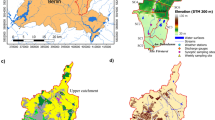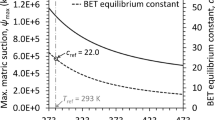Abstract
Stormwater biofilters manage quantity and quality of urban stormwater runoff. Particulate solids from natural and anthropogenic sources accumulate on paved surfaces and eventually reach receiving waters. Retention of suspended solids in stormwater management systems ensures the quality of stormwater runoff to water resources. Stormwater biofilters are similar in most of design parameters to sand filters employed in water treatment systems. The understanding and design of stormwater biofilters are often based on generic models of sand filters. Unlike water treatment sand filters, which are continuously fed, stormwater biofilters operate intermittently with spontaneously alternating wetting and drying cycles. This results in dynamic pollutant removal pattern that employs different mechanisms during and across rainfall events. As such, pilot scale biofilter columns fabricated with a layer of organic material were operated. Removal of suspended solids was very dynamic, where impact of age of filter, antecedent dry days, and inflow quality varied during and across events. Flush of retained solids and filter material occurred during the stabilisation period during each event while very high removal percentages (more than 90%) were observed after stabilisation, during an event. Clogging was not observed due to re-entrainment, re-distribution, and flush of retained solids during intermittent wetting and drying cycles.






Similar content being viewed by others
Abbreviations
- ADD:
-
Antecedent dry days
- EN:
-
Event number
- TUIN:
-
Turbidity of inflow of current event
- TUPRE:
-
Turbidity of inflow of previous event
- TUOUT:
-
Turbidity of outflow
- min(t) [min2, min7, etc.]:
-
TUOUT at “t” minutes during an event (2 min, 7 min, etc.)
- TSS:
-
Total suspended solids
- PSD:
-
Particle size distribution
References
Ahfir, N., Wang, H. Q., Benamar, A., Alem, A., Massei, N., & Dupont, J. (2007). Transport and deposition of suspended particles in saturated porous media: Hydrodynamic effect. Hydrogeology Journal, 15, 659–668.
Alem, A., Elkawafi, A., Ahfir, N., & Wang, H. (2013). Filtration of kaolinite particles in a saturated porous medium: Hydrodynamic effects. Hydrogeology Journal, 21, 573–586.
Bilotta, G. S., & Brazier, R. E. (2008). Understanding the influence of suspended solids on water quality and aquatic biota. Water Research, 42, 2849–2861.
Blecken, G., Zinger, Y., Deletic, A., Fletcher, T. D., & Viklander, M. (2009). Impact of a submerged zone and a carbon source on heavy metal removal in stormwater biofilters. Ecological Engineering, 35, 769–778.
Boller, M. A., & Kavanaugh, M. C. (1995). Particle characteristics and headloss increase in granular media filtration. Water Research, 29(4), 1139–1149.
Bradford, S. A., Simunek, J., Bettahar, M., van Genuchten, M., & Yates, S. R. (2003). Modeling colloid attachment, straining, and exclusion in saturated porous media. Environmental Science and Technology, 37(10), 2242–2250.
Davis, A. P., Shokouhian, M., Sharma, H., Minami, C., & Winogradoff, D., (2003). Water quality improvement through bioretention: lead, copper, and zinc removal. Water Environment Research, 75(1), 73–82.
Davis, A. P., Shokouhian, M., Sharma, H., & Minami, C. (2006). Water quality improvement through bioretention media: nitrogen and phosphorous removal. Water Environment Research, 78(3), 284–293.
Ellis, J. B., & Revitt, D. M. (2008). Defining urban diffuse pollution loadings and receiving water hazard. Water Science & Technology, 57(11), 1817–1823.
Gold Coast City Council (2003). Goldcoast planning scheme 2003 Policy 11 - Land development guidelines. Gold Coast City Council: Goldcoast.
Hoffman, E. J., Latimer, J. S., Mills, G. L., & Quinn, J. G. (1982). Petroleum hydrocarbon in urban runoff from a commercial land use area. Journal (Water Pollution Control Federation), 54(11), 1517–1525.
Hsieh, C. H., Davis, A. P., & Needelman, B. A. (2007). Nitrogen removal from urban stormwater runoff through layered bioretention columns. Water Environment Research, 79(12), 2404–2411.
Johnson, W. P., Li, X., & Assemi, S. (2007). Deposition and re-entrainment dynamics of microbes and non-biological colloids during non-perturbed transport in porous media in the presence of an energy barrier to deposition. Advances in Water Resources, 30(6–7), 1432–1454.
Kim, Y., & Whittle, A. J. (2006). Filtration in a porous granular medium: 1. Simulation of pore-scale particle deposition and clogging. Transport in Porous Media, 65(1), 53–87.
Lee, J., & Koplil, J. (2001). Network model for deep bed filtration. Physics of Fluids, 13(5), 1076–1086.
Li, H., & Davis, A. P. (2008a). Urban particle capture in bioretention media. I: laboratory and field studies. Journal of Environmental Engineering, 134(6), 409–418.
Li, H., & Davis, A. P. (2008b). Urban particle capture in bioretention media. II: theory and model development. Journal of Environmental Engineering, 134(6), 419–432.
Liu, A. (2011). Influence of rainfall and catchment characteristics on urban stormwater quality [Doctor of Philosophy: Queensland University of Technology.
Mays, D. C., & Hunt, J. R. (2004). Hydrodynamic aspects of particle clogging in porous media. Environmental Science and Technology, 39(2), 577–584.
Miguntanna, N. P. (2009). Nutrients build-up and wash-off processes in urban land uses [Doctor of Philosophy: Queensland University of Technology.
Newcombe, G., & Dixon, D. (2006). Interface science in drinking water treatment. London: Elsevier Publishing Interface science and technology.
Parker, N. (2010). Assessing the effectiveness of water sensitive urban design in SouthEast Queensland [Master of engineering]. Brisbane: Queensland University of Technology 235 p.
Raskin, I., Smith, R. D., & Salt, D. E. (1997). Phytoremediation of metals: Using plants to remove pollutants from the environment. Current Opinion in Biotechnology, 8(2), 221–226.
Reddi, L. N., Xiao, M., Harja, M. G., & Lee, I. M. (2005). Physical clogging of soil filters under constant flow rate versus constant head. Canadian Geotechnical Journal, 42(3), 804–811.
Sen, K. T., & Khilar, K. C. (2006). Review on subsurface colloids and colloid-associated contaminant transport in saturated porous media. Advances in Colloid and Interface Science, 119(2–3), 71–96.
Shinya, M., Tsuchinaga, T., Kitano, M., Yamada, Y., & Ishikawa, M. (2000). Characterization of heavy metals and polycyclic aromatic hydrocarbons in urban highway runoff. Water Science & Technology, 42, 201–208.
Siriwardene, N. R., Deletic, A., & Fletcher, T. D. (2007). Clogging of stormwater gravel infiltration systems and filters: Insights from a laboratory study. Water Research, 41, 1433–1440.
South East Queensland Healthy Waterways (2010) Construction and establishment guidelines: Swales, bioretention systems and wetlands. South East Queensland Healthy Waterways Partnership: Brisbane.
Subramaniam, D. N. (2015). Dynamics of nitrogen and suspended solids removal in experimental stormwater biofilters under intermittent wetting and drying [Doctor of Philosophy]. Brisbane: Queensland University of Technology.
Subramaniam, D. N., Egodawatta, P., Gallage, C. P. K., Mather, P., & Rajapakse, J. (2014a). Significance of drying periods on nitrate removal in experimental biofilters. Journal of Water Management Modeling: Toronto, C381. https://doi.org/10.14796/JWMM.C381.
Subramaniam, D. N., Egodawatta, P., Mather, P., & Rajapakse, J. (2014b). Stabilization of experimental bioretention basins during intermittent wetting and drying, stormwater Queensland conference: Visions to realities: Noosa Heads.
Subramaniam, D. N., Egodawatta, P., Mather, P., & Rajapakse, J. P. (2015). Stabilization of stormwater biofilters: impacts of wetting and drying phases and the addition of organic matter to filter media. Environmental Management, 56(3), 630–642.
Subramaniam, D., Mather, P., Russell, S., & Rajapakse, J. (2016). Dynamics of nitrate-nitrogen removal in experimental stormwater biofilters under intermittent wetting and drying. Journal of Environmental Engineering, 142(3), 04015090.
Torkzaban, S., Bradford, S. A., & Walker, S. L. (2007). Resolving the coupled effects of hydrodynamics and DLVO forces on colloid attachment in porous media. Langmuir, 23(19), 9652–9660.
Veerapaneni, S., & Wiesner, M. R. (1997). Deposit morphology and head loss development in porous media. Environmental Science and Technology, 31(10), 2738–2744.
Walsh, C. J. (2000). Urban impacts on the ecology of receiving waters: A framework for assessment, conservation and restoration. Hydrobiologia, 431, 107–114.
Acknowledgments
The authors would like to thank River Sands Pty Ltd., Australia, for supplying the stormwater biofilter packing material for my experiments. The authors would also like to thank Queensland University of Technology and University of Jaffna for funding my research study. And the authors extend my sincere gratitude to Dr. Prasanna Egodawatta, Dr. Jay Rajapakse, and laboratory staff at QUT and University of Jaffna for the support during the study.
Author information
Authors and Affiliations
Corresponding author
Rights and permissions
About this article
Cite this article
Subramaniam, D.N., Logeswaran, T., Tharshikka, V. et al. Dynamics of Clay Particles in Non-vegetated Stormwater Biofilters. Water Air Soil Pollut 229, 302 (2018). https://doi.org/10.1007/s11270-018-3919-6
Received:
Accepted:
Published:
DOI: https://doi.org/10.1007/s11270-018-3919-6




